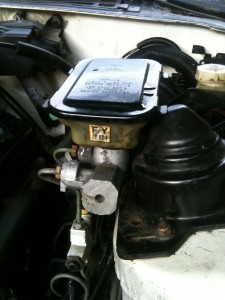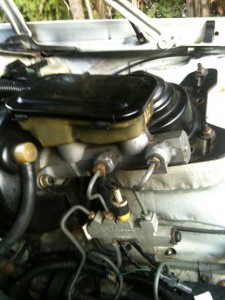The fluid reservoir does exactly that. It stores and supplies fluid to the master cylinders of your brakes.
Fluid is incompressible. So it acts like a liquid linkage between the master cylinder and each of the wheel brakes. When you press the brake pedal, the force is instantly transferred to the brakes. The master cylinder has a push rod and a pair of pistons that exert force against the fluid in the cylinder bore. When you push the brakes, the pistons in the master cylinder push against the fluid, which flows through the brake lines and pushes the caliper pistons outward to apply the disc brakes. When you release the brake pedal, the spring loaded piston in the master cylinder returns to its rest position. The fluid that was displaced by the pistons is pushed back to the master cylinder as the brake pads retract.
My Camaro has a plastic reservoir that is attached to a composite master cylinder. It is held in place by a pair of O-rings. The translucent plastic allows me to see the fluid level inside without having to open the filler cap-which helps keeps the system free of moisture and dirt.
There were no fluid sensors for the brakes system in my particular model year.
Tips:
1. Keep the reservoir full-but don’t over fill it! Keep your fluid at the full mark, because it drops as your brake pads wear. It if gets too low, air can be drawn in. Unlike brake fluid, (yes, I know air a a gaseous fluid) air is compressible and will reduce hydraulic pressure, creating a soft and/or low brake pedal. If you over fill the fluid reservoir, you’ll prevent the fluid to return after the brakes you let off the brakes. Also, a little space is needed for the changes in fluid volume that results from temperature changes.
2. Keep out anything that doesn’t belong in the reservoir. No oil, no power steering, transmission, coolant, or water! Anything with oil distillates in it can attack and ruin the rubber components in the brake system (O-rings etc.) If you do accidentally get anything but brake fluid in the system, you’re going to have to disassemble, rebuild or replace the master cylinder, calipers and wheel cylinder and flush the system with new brake fluid. Also, make sure you avoid getting dirt into the system as it acts as an abrasive and can plug up the master cylinder.
On the third gen, you have a dual master cylinder. This is good because a leak in a single piston master system will cause you to have no brakes!
One half of the master cylinder works the front brakes and the other the rear. (Front wheel drive cars split the system diagonally.) The GM cars past 1980 had a special kind of master cylinder called a “quick take-up” master cylinder. This design reduces the brake drag by using a stepped bore that delivers a large volume of fluid when the brake pedal is initially depressed. This allows the caliper piston seals to retract the pistons when the brakes are released so the pads don’t drag against the rotors. The old method required the rotors to kick out the pads so they didn’t rub. The drawback with this design is that the caliper pistons have to travel further when you apply the brakes and the reservoir has to hold more fluid.
If you compare a master cylinder from an 80’s GM car with some other car manufactures (think Honda) the GM brake fluid reservoir is huge!



